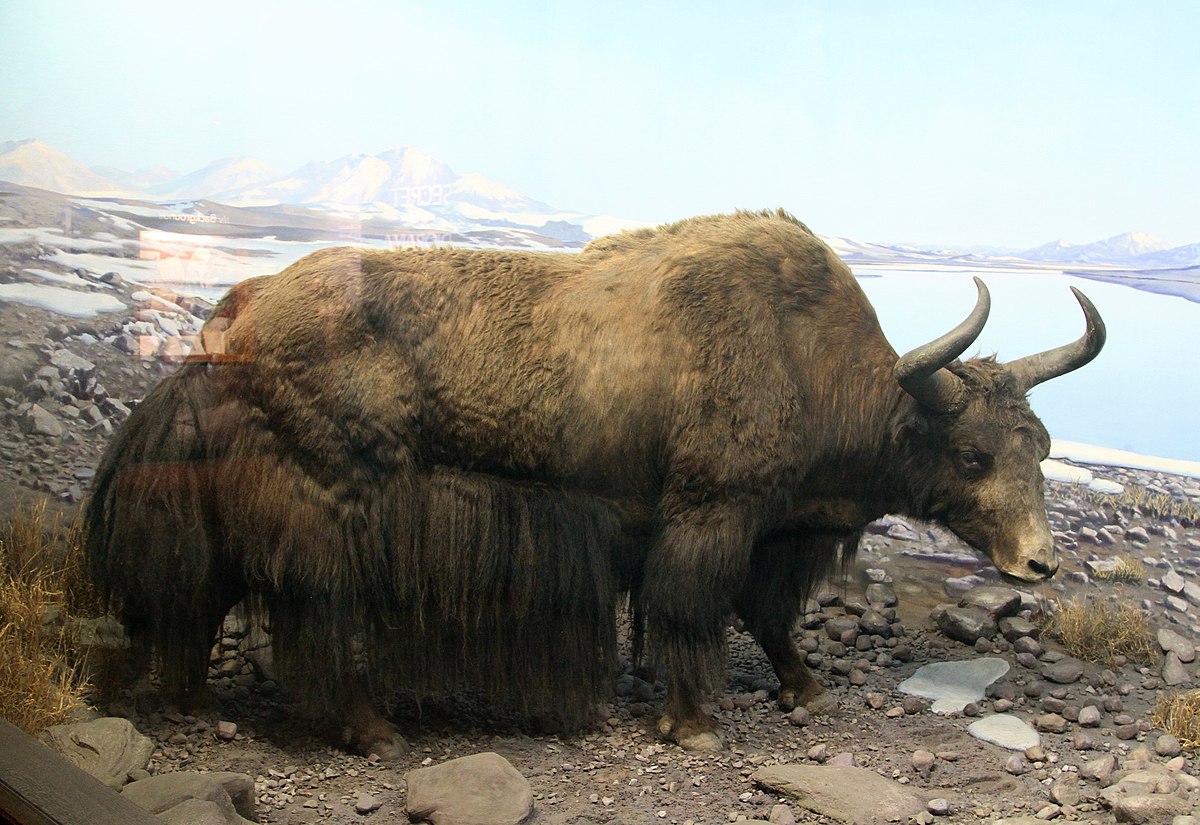Unraveling the Roots of the Yak
The yak, known scientifically as Bos grunniens, is integral in ecosystems and human societies scattered across Asia’s towering altitudes. From the Himalayas’ rugged terrains to the Tibetan Plateau’s expansive stretches, yaks are not merely residents; they are vital components of survival and symbiotic relationships in these regions. Originating from their wild ancestors, the Bos mutus, these robust creatures have seamlessly intertwined their existence with the habitats and communities they grace.
A Sturdy Creature Amidst Harsh Climes
The environment where the yak thrives is nothing short of harsh, yet this resilient creature exhibits a magnificent knack for surviving and flourishing amidst these challenging conditions. Their long, shaggy hair provides an iconic appearance and a functional adaptation, ensuring insulation against the bitter cold. Moreover, their large lungs and robust hearts cater to high-altitude environments where oxygen is notably scarce. The yak, thus, symbolizes strength and adaptability, characteristics that are both admirable and essential.
Economical and Eco-Friendly Providers
In regions where the yak is native, human societies have garnered a wealth of benefits from these beings for centuries. Beyond their apparent contributions, like providing milk, meat, and hide, yaks have facilitated sustainable and eco-friendly living amidst the often inhospitable terrains of high-altitude landscapes. They transport goods across treacherous paths, ensuring communities remain connected despite geographical isolation. Their dung serves as a vital fuel source, offering an eco-friendly alternative to timber and helping mitigate deforestation in these fragile ecosystems.
Cultural Significance and Spiritual Symbology
Yaks have not merely satisfied material and nutritional needs but have also seeped deeply into their cohabit societies’ cultural and spiritual realms. They are often seen as symbols of prosperity and endurance in various regions. Festivals and events, such as the Yak Festival in Bhutan, celebrate the animal and the intricate and enduring relationship between man and beast, accentuating a deep-seated respect and mutual reliance woven through generations.
The Concern of Preservation and Ethical Considerations
Given their invaluable contribution to ecosystems and human societies, the preservation of yak populations and ethical considerations in their utilization are paramount. Ensuring that yaks can sustainably coexist with humans without being subjected to undue stress or exploitation requires a mindful approach towards breeding, herding, and utilizing the resources they provide. Equitable practices ensure that while human societies continue to derive sustenance and support from yaks, the well-being and continuity of these magnificent creatures are not compromised.
Embarking on a Conscious Journey Together
As we peer into the world of yaks, observing their splendid adaptation, substantial contributions, and the rich tapestries of culture and economy they help weave, a profound respect emerges for these beings. Balancing utilization with conservation and acknowledging their worth beyond mere resources engenders a relationship that is not just sustainable but profoundly enriching. Together, man and yak traverse the undulating terrains, embarking on a journey that is at once physical, economical, and profoundly spiritual, continuing a partnership that has weathered both time and clime.
Striking a Balance with Biodiversity
Yaks, with their formidable presence, also play a pivotal role in maintaining the delicate balance of the high-altitude ecosystems they inhabit. These ecosystems, while appearing rugged and resilient, are, in fact, delicately balanced and incredibly sensitive to changes. Through their grazing, Yaks help regulate plant populations, while their movements across vast terrains assist in seed dispersal, thereby facilitating the proliferation of various flora across expansive regions. This not only aids in maintaining the ecological balance but also ensures the sustenance of other species that co-inhabit these terrains.
Delving into Yak-Based Products
Yaks offers many products that have found a secure place in the markets not only of local communities but also in international trade. Yak wool, renowned for its warmth, softness, and durability, is woven into both functional and fashionable garments. Similarly, yak milk, often transformed into cheese, is a local staple and a delicacy that has found its way into global culinary circles. However, while the yak provides abundantly, it is imperative to ensure that the extraction of these resources is conducted in a manner that is sustainable and does not impede the well-being of the animals.
Yaks in Modern Research and Science
In scientific research, yaks are a subject of fascination due to their remarkable adaptability and resilience to environments that are typically hostile to other forms of livestock. Understanding the genetic and physiological mechanisms that enable yaks to thrive in high-altitude, low-oxygen environments provides insights that have broader applications. This includes research in medical science, particularly in understanding and potentially developing treatments for low-oxygen conditions in humans. However, such research must be conducted with a rigorous adherence to ethical guidelines, ensuring that the yaks are not subjected to distress or harm.
Yaks and Climate Change: A Vital Connection
The robust yak is also not immune to the more considerable global challenges climate change presents. The alterations in temperature and weather patterns have cascading effects on the habitats of the yaks. Altered grazing patterns, changes in available vegetation, and shifts in migratory pathways are among the numerous challenges yaks face in the rapidly changing climate. Protecting yaks is not merely about preserving a species but about safeguarding an entire ecosystem that is fundamentally interwoven with their existence.
Engaging with the Yak Community Responsibly
For travellers, adventurers, and those simply curious about the majestic yaks and the cultures that have burgeoned around them, engagement must be imbued with respect and responsibility. Observing and participating in local practices, such as yak herding or cheese-making, should be approached with a conscientious mindset that prioritizes the well-being of the animals and respects local traditions and knowledge.
Wrapping up the Yak Narrative
In culmination, the yak emerges not merely as a creature of survival and sustenance but as a being that generously contributes to the ecological, economic, and cultural tapestries of the regions it inhabits. The narratives of yaks and humans are interwoven with threads of mutual reliance, respect, and shared journeys through the often harsh landscapes of life. As we reflect upon, engage with, and become a small part of this intricate tapestry, let us carry forward a spirit of respect, conservation, and genuine appreciation for the remarkable world of the yak. And as we tread on, may our steps be guided by mindfulness, ensuring that the stories of yaks and humans unfold harmoniously through time’s annals.
Frequently Asked Questions about Yaks
What Environments Do Yaks Thrive In?
Yaks are inherently adapted to harsh, high-altitude environments, mainly thriving in the formidable conditions of the Himalayan region, the Tibetan Plateau, and similar elevated terrains extending to Mongolia and Siberia. These regions, characterized by their scarce oxygen levels and chilling temperatures, are where yaks exhibit remarkable resilience and adaptability.
How Do Yaks Contribute to Eco-Friendly Living?
Yaks significantly contribute to eco-friendly living through various means. Their dung is a vital fuel source, offering an environmentally conscious alternative to using wood and helping mitigate deforestation. Additionally, yaks assist in maintaining biodiversity by regulating plant populations through grazing and aiding seed dispersal, thus facilitating the proliferation of varied flora.
Are Yaks Utilized for Their Products?
Yes, yaks are invaluable for the diverse range of products they provide. Yak wool, distinguished for its warmth and durability, is woven into various garments. Yak milk, noted for its nutritional value, is often transformed into cheese and other dairy products, sustaining local diets and making its way into global culinary offerings.
How Are Yaks Embedded in Cultural and Spiritual Practices?
Yaks are deeply embedded in the cultural and spiritual fabric of the societies they coexist with. They are often symbolized as representations of prosperity and endurance. Numerous events and festivals, such as Bhutan’s Yak Festival, celebrate these majestic creatures and the symbiotic relationship between yaks and humans. This highlights the deep-rooted respect and mutual dependence cultivated over generations.
What Threats Do Yaks Face in the Context of Climate Change?
Despite their formidable nature, Yaks are not impervious to climate change’s impacts. Alterations in weather patterns affect their habitats, disrupting available vegetation, altering grazing practices, and potentially shifting migratory pathways. Consequently, preserving yaks becomes synonymous with safeguarding an entire ecosystem intricately intertwined with their existence.
How Can Tourists Engage Respectfully with Yak Communities?
Engaging respectfully with yak communities involves a conscientious approach that prioritizes the well-being of the animals and honours local traditions and knowledge. Visitors should observe and, when appropriate, participate in local practices, ensuring that their engagement is mindful and appreciative and does not impede the well-being or operations of the community and the yaks.
How Is the Yak Population Maintained Sustainably?
The sustainable maintenance of yak populations involves mindful approaches to breeding, herding, and utilizing their resources. Equitable practices ensure that while human societies derive various forms of sustenance and support from yaks, the animals’ well-being and continuity are not compromised, thereby fostering a relationship that is both sustainable and mutually enriching.



